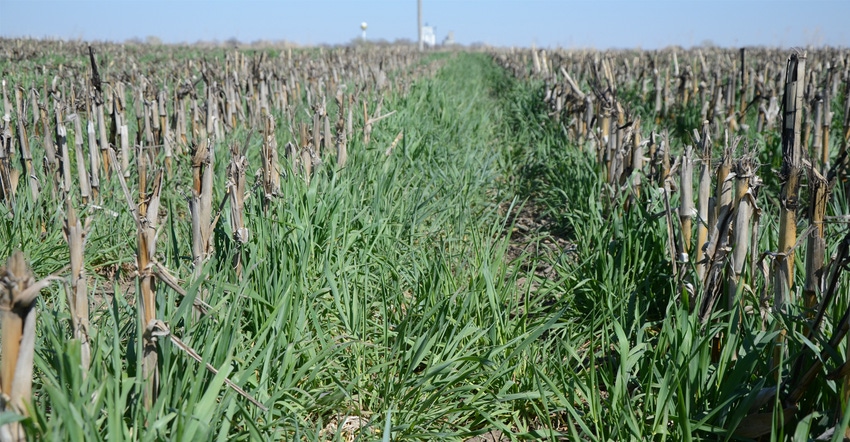
If there's one thing farmers can discuss universally, it's weather. And there's no denying the Midwest has seen its share of extreme weather events lately — including the drought of 2012 and 2019 flood events in Nebraska.
In the wake of these events, questions have arisen regarding what practices growers can use to help mitigate the effects of drought, heavy rainfall and runoff, and saturated soils. A recent meta-analysis of 89 studies across the globe has been conducted by University of Nebraska-Lincoln researchers to identify which ag practices provide the greatest benefit to soil water infiltration.
Andrea Basche, UNL assistant professor of agronomy and horticulture and one of the study's authors, explains that the meta-analysis provides a systematic review of studies from six continents.
Side-by-side comparison
With a meta-analysis, researchers are able to identify studies across a broad spectrum that fit a certain criteria — in this case, those that measure infiltration and that compare alternative and conventional practices side-by-side.
Focusing on infiltration allowed researchers to better understand the relative benefits of different practices — comparing them using a single, specific measure of soil water that's relatively comprehensive and closely related to other characteristics of soil and soil water management.
Infiltration rates also are commonly used in field experiments, and often are shared anecdotally among farmers at local coffee shops after rain events. Basche has heard these stories herself, including in Nebraska and during her research at the Leopold Center for Sustainable Agriculture at Iowa State University.
"During those conversations [in Iowa], there were a number of farmers who shared anecdotes about improved infiltration on their farms and/or neighboring farms where there are cover crops or no-till practices utilized," she says.
Basche and Marcia DeLonge, senior scientist in the Food and Environment Program at the Union of Concerned Scientists, analyzed the effects of five practices: no-till, cover crops, crop rotations, planting perennials and cropland grazing. They also measured a range of soil attributes and environmental variables — however, they found soil type didn't make a difference in how effective these practices were.
Basche and DeLonge found the practices that increased infiltration most consistently were those that keep roots growing in the soil, such as cover cropping and perennial planting. Studies included in the meta-analysis covered a range of cover crop species, including radish, sunn hemp, soybean, crimson clover, oat, vetch, winter rye, barley, annual ryegrass and cowpea, as well as other legumes.
The analysis found that planting perennials such as grasses or trees near cropland increases the rate of water absorption by an average of 59%. Cover crops improved water absorption by an average of 35%, according to data from 23 studies.
Interestingly, synthesized data from 52 studies found no overall effect on water infiltration from no-till. Rotating among cash crops also seemed to have no substantial influence, at least at the aggregate level.
Meanwhile, allowing livestock to graze on cropland actually reduced water infiltration by an average of 21%. The loss of residue and vegetative cover may be one reason for the reduction in infiltration after grazing livestock.
"We wanted to see how many studies we could find focused on cropland grazing, but there were not any experiments that really fit our criteria that included grazing cover crops," Basche says. "For some studies, it would have been adding cows in a way you might graze cornstalks, and for others it might have been grazing livestock on a forage crop compared to haying the forage crop. You could also be grazing cover crops and not see that effect. There is good research in Nebraska showing no negative effect on infiltration with cattle grazing cover crops."
Whole system approach
A recent article on UNL's CropWatch website highlights Basche's recent trip to Washington, D.C., where she presented to a congressional caucus focused on soils. After discussing post-1980 increases in heavy rainfall across much of the U.S., Basche shared lessons from the meta-analysis, other research and an ongoing study of 17 field sites across Nebraska.
Part of the challenge ahead, she said, is demonstrating the value of soil-friendly practices and encouraging their adoption. Cover crops currently are planted on less than 10% of U.S. cropland.
Basche notes the increased frequency of heavy spring rain events as one reason for integrating cover crops into a rotation. An analysis of the 2018 National Climate Assessment by the Nebraska State Climate Office showed that over the past 30 years, Nebraska's climate became wetter, with an increase of 2 inches in annual average precipitation — with a 1.2-inch increase in the spring.
Meanwhile, parts of the state have seen a drying trend throughout the rest of the year. And practices such as cover cropping can increase soil infiltration to hold more water for when the crop needs it.
"It's really about thinking about your whole system," Basche says. "You are losing water from runoff, and if you get a heavy rain event and don't get rain for weeks after, you want to hold that rain in your soil. It's an opportunity cost. If you don't have a plant growing, you're missing an opportunity to put down roots, improve soil structure, organic matter and have aboveground biomass that can protect from erosion as well as water loss directly."
"My hope is people realize there are strategies we can use to protect the soil from increasing heavy rain events," she adds. "This analysis shows soil can be a solution to offsetting the impacts of heavy rain events and drought."
About the Author(s)
You May Also Like






